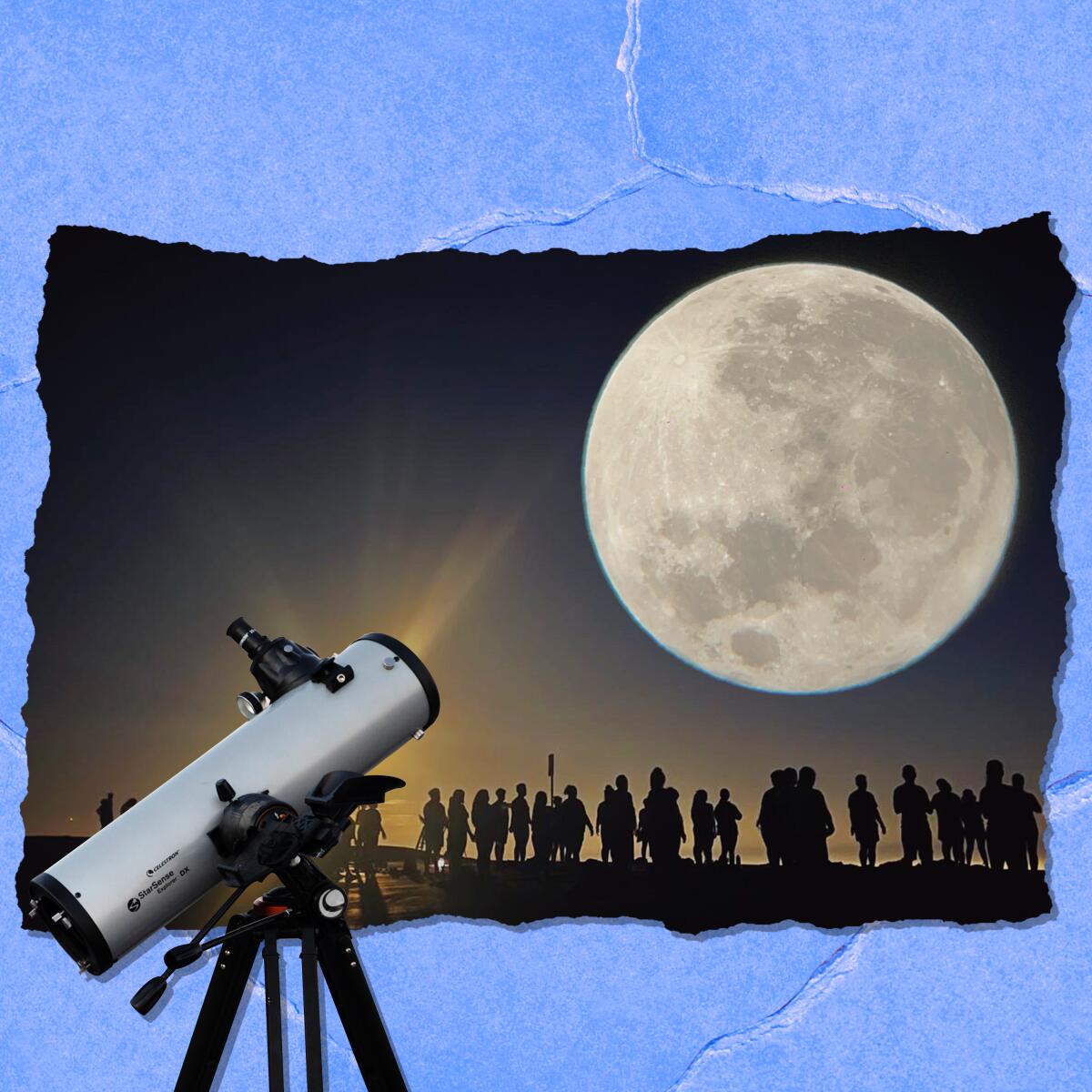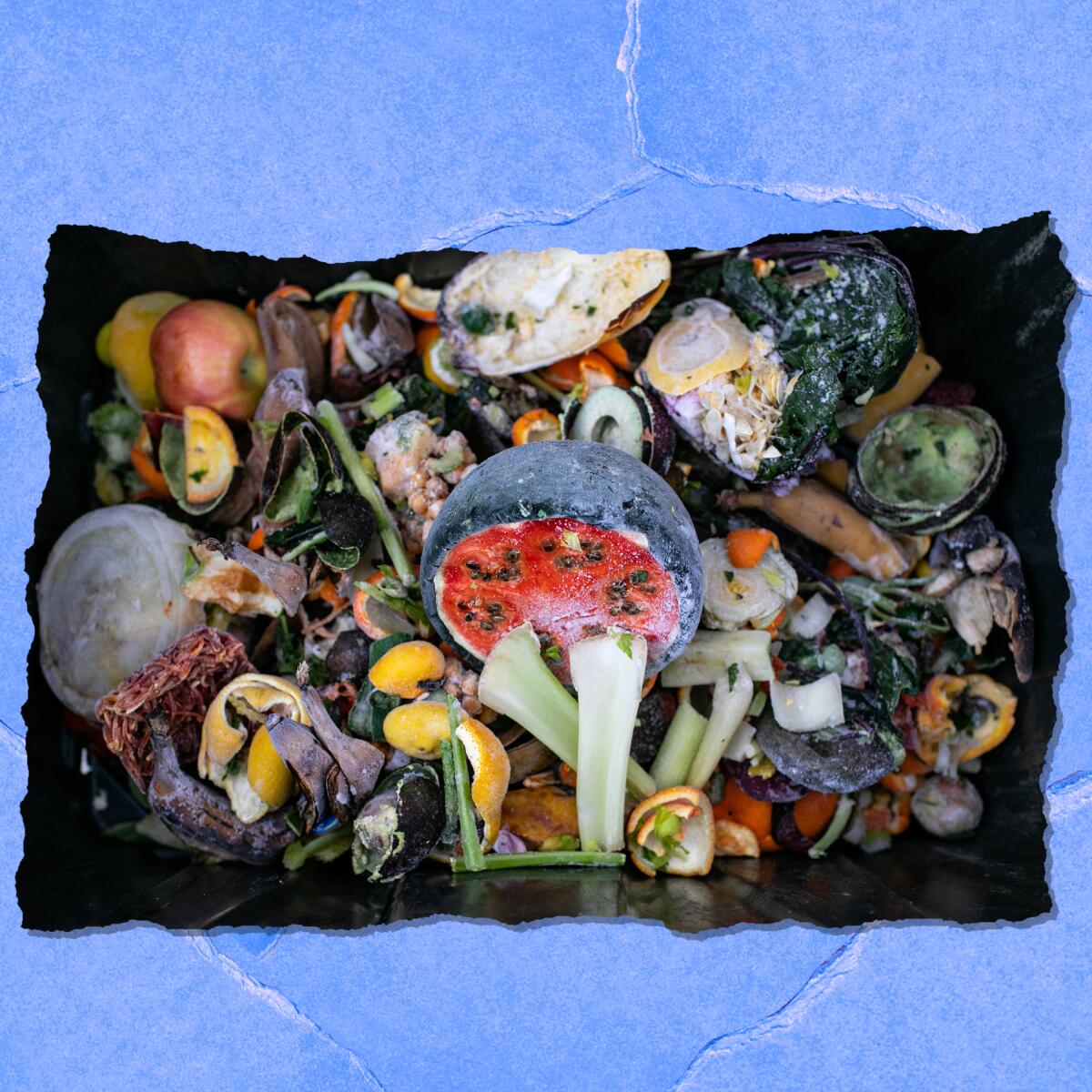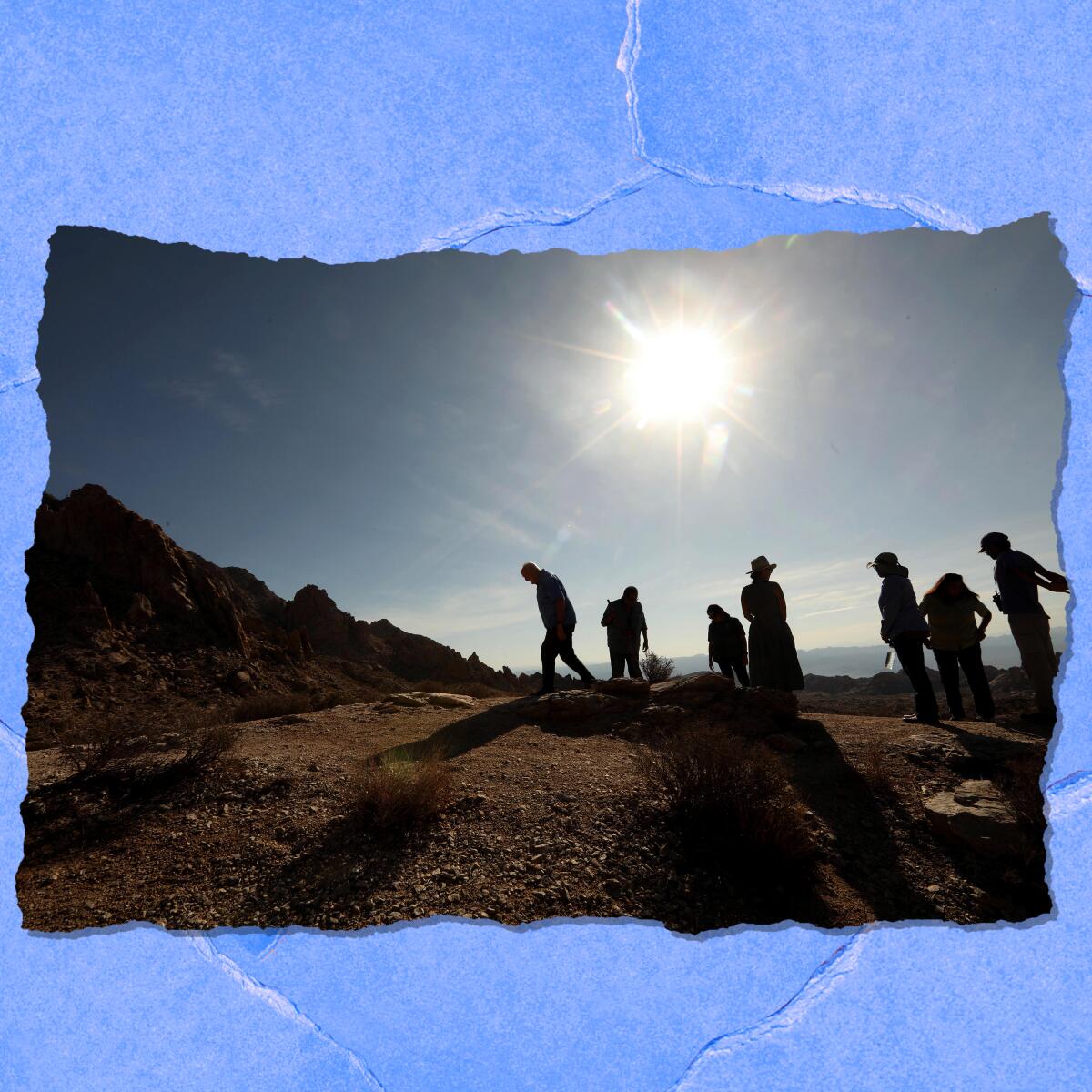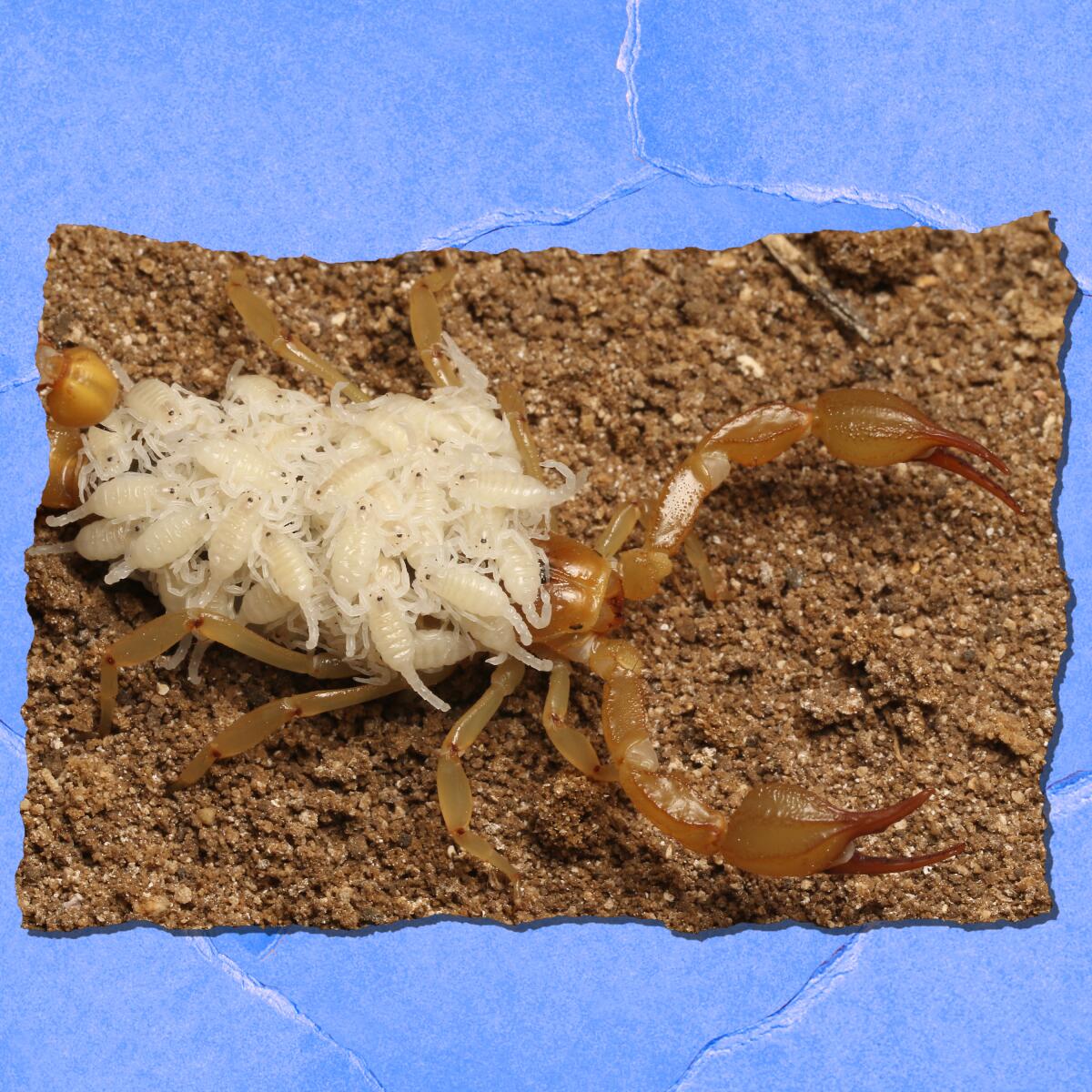Meet the SoCal professor who hiked 500 miles across the Mojave Desert

In teaching geology, many professors might crack open a textbook or click through a PowerPoint presentation. Nick Van Buer, an associate professor of geology at Cal Poly Pomona, has something far more interesting to share: stories, videos and maybe even a few cool scars from his 530-mile hike across the Mojave Desert.
He embarked on the trek earlier this year as a sabbatical project and documented the journey in a YouTube series called “Across the Mojave on Foot.” The expedition took 35 days, over which he climbed the equivalent of two Mt. Everests (13.5 miles total) across 15 mountain ranges and 20 wilderness areas. It’s an incredibly impressive and unique desert trek.
I had the chance to chat with Van Buer last week. Here’s what he told me about the expedition.
Get The Wild newsletter.
The essential weekly guide to enjoying the outdoors in Southern California. Insider tips on the best of our beaches, trails, parks, deserts, forests and mountains.
You may occasionally receive promotional content from the Los Angeles Times.
Why he did it: Specializing in late Mesozoic hard-rock geology and having a particular interest in the desert, Van Buer wanted to further understand Mojave geology. He collected samples, including some granite pieces he believes represent “the roots of supervolcanoes present during the age of the dinosaurs.” The experience will also benefit his classroom — he’ll be using the videos, which feature tons of fascinating geological interpretation, as part of his lectures. He hopes to inspire future geologists and encourage young people to pursue STEM studies.
The path: From January to March, Van Buer walked from the Mexican border near Yuma, Ariz., to the Sierra Nevada Mountains near the California community of Olancha. He covered up to 31 miles per day, with elevations ranging from -280 to 7,440 feet, and 95% of the trip was off-trail (in fact, he saw only three hikers the entire trip). Unlike the Pacific Crest Trail, there’s no defined connecting path — Van Buer calls it the “Mojave Wilderness Route.” He lays claim to the most distance covered using only wilderness areas along the route. “My students call this ‘Van Buering,’” he said.
The toughest spots: Though Van Buer planned for over nearly 10 years and has plenty of long-distance desert-hiking experience, the trek was not without some big challenges. “I seemed to have planned this trek with just enough knowledge of my abilities to make it possible, but with enough over-optimism [for it] to be extremely difficult,” he noted. The toughest stretch saw him hike for 16 hours across 31 miles in a part of Death Valley where camping is not allowed. He also had to traverse the rugged Avawatz Mountains while relying on 100-year-old map records. Van Buer even swam across the Colorado River multiple times, and one section had him pushing through over 150 feet of reeds for two hours. That was “the only section of the trip I wouldn’t do again,” he said.
His supplies: He carried a Garmin inReach for communication and a 70-pound pack. Van Buer’s family and friends resupplied food seven times, but he used 13 natural sources to refill water, including one in which he had to dig more than three feet. He cooked his own bread using a technique he learned in the Ladakh Himalaya, throwing the flour right on the coal. (“That is just insane,” he says in his YouTube show, taking a bite of the bread he just made. “Maybe it’s the hunger talking, but this bread is good.”)
What he saw: Crossing “1.8 billion years of geological history” is pretty special on its own, but Van Buer told me the most exciting geological find was in the Panamint Mountains of Death Valley. An effect of the snowball earth, there was the juxtaposition of 635-million-year-old glacial-origin sediment directly below a 10,000-year-old tropical reef environment. It wasn’t all rocks — he saw mining shafts, stone shelters, petroglyphs and metates (grinding bowls) carved directly into stone. His most beautiful moment was finding a little fern- and moss-covered waterfall in the Avawatz Mountains. “A waterfall is one thing,” he said, “but being surrounded by miles and miles of rocks in the desert makes it truly amazing.”
The overall experience: While Van Buer looks back on the hike “more fondly now” than when he just completed it, he told me confidently, “Yes, I would do it again.”
Check out “The Times” podcast for essential news and more.
These days, waking up to current events can be, well, daunting. If you’re seeking a more balanced news diet, “The Times” podcast is for you. Gustavo Arellano, along with a diverse set of reporters from the award-winning L.A. Times newsroom, delivers the most interesting stories from the Los Angeles Times every Monday, Wednesday and Friday. Listen and subscribe wherever you get your podcasts.
5 things to do this week

1. Play under the full moon in Elysian Park. On Saturday at 5 p.m., join We Explore Earth and other community partners on the 2.6-mile urban gem Angel’s Point Loop for sunset and full moon DTLA vistas. There will also be telescopes to check out the lunar event, a yoga session and skating on the helipad overlooking the city. Register here.

2. Check out photorealistic paintings of our local environment at King Gillette Ranch in Calabasas. Photorealist Connie Jenkins will be on site from 2 to 4 p.m. on Saturday at the Santa Monica Mountains Interagency Visitor Center to share her beautiful paintings as part of the “Ocean/Mountains” exhibition, including pieces on the Woolsey fire and the Channel Islands National Park tide pools. Make it a full day at SMMNRA with a morning native plant restoration effort at Rancho Sierra Vista and a full moon hike at Paramount Ranch.

3. Watch for waterfowl at the Bolsa Chica State Ecological Reserve in Huntington Beach. Led by the Los Angeles chapter of the Feminist Bird Club, the beginner-friendly birding event starts at 8 a.m. on Saturday and explores the largest salt marsh in coastal California. More than 200 avian species have been identified at the 1,445-acre estuary, so bring your spotting scopes and binoculars (some binoculars and bird books will be available to lend out).

4. Discover the Okinawan composting tradition of Bokashi at Zenshuji Soto Mission in Little Tokyo. On Saturday, from 10 a.m. to noon, join Hiro’s Bokashi Club to learn about the method, which “uses a mix of microorganisms that combats food rotting bacteria (and rotting odors), increases the speed of decomposition and enhances plant growth.” Learn more on Sustainable Little Tokyo’s website, which features an informative “How to Bokashi” zine.

5. Attend a Mid-Autumn Festival to celebrate family, friends and the moon. Every year, the nearly 3,000-year-old event takes place on the 15th day of the eighth month of the lunar calendar — for 2022, that is Saturday, Sept. 10. The tradition, also known as the Moon Festival, honors the full, bright Harvest Moon via family reunions and eating mooncakes. Check out festivals across town this Saturday, from Temple City to Orange County to Riverside. Chinatown’s annual event is Sept. 17.

The must-read
Can a sacred mountain become a national monument? Mojave Desert tribes are seeking to make that happen, reports Times writer Louis Sahagún. Along with the support of environmentalists, biologists and artists, a coalition of Native Americans has proposed the creation of the Avi Kwa Ame National Monument. The 443,671-acre area contains diverse biological zones and would connect the Mojave National Preserve, Castle Mountains National Monument, Mojave Trails National Monument and Dead Mountain Wilderness Area in California with Lake Mead National Recreation Area in Nevada. It’s also home to the 5,600-foot Spirit Mountain (Avi Kwa Ame), where many Native Americans have made pilgrimages “to seek religious visions and give thanks for Earth’s bounty.” Whether you believe in the sacred or the science, we can all agree it’s important to continue protecting our lands.

The red flag
We’re having one hell of a heat wave. But why now? Times writers Grace Toohey and Alexandra E. Petri recently delved into the phenomenon “that typically brings broiling conditions to the state as summer fades into fall.” It’s colloquially known as a “heat dome,” and UCLA climate scientist Daniel Swain describes it as a “strong region of atmospheric high pressure during the warm months” that traps heat. Climate change is making the effects more extreme — so much so that retired climatologist Bill Patzert now calls it “global heating.” Whatever the term, it’s undeniably dangerous (it’s even adding new dangers for our firefighters), so do your best to stay safe.

Wild things
“O, full of scorpions is my mind!” Although Macbeth is referring to his guilty conscience, university students Prakrit Jain and Harper Forbes really do think about the arachnids all day. Times reporter Jonah Valdez shared that Jain and Forbes recently discovered two new species of scorpions in California — one at the Soda Lake playa in San Luis Obispo County’s Carrizo Plain, and the other at Kern County’s Koehn Lake playa in the Mojave Desert. With the help of Lauren Esposito, an arachnologist at the California Academy of Sciences, they published their findings and urged that the limited range of the Mojave species merits consideration for the endangered species list. Both face threats from global warming and human development, and this may be a much needed push for more protection for scorpions.

P.S.
Summer clearly isn’t going away just yet. The good news? Now’s the perfect time to stay indoors and plan your next trip. Whether you’re considering a short hike to a swimming hole, a Mt. Whitney training trek or an epic backpacking trip (like writer Mary Forgione completed on the Trans-Catalina trail) over the next few weeks, start prepping your pack with what’s most important: snacks. Check out why I think the best place to stock up on hike bites and camp meals is your local Asian market.
For more insider tips on Southern California’s beaches, trails and parks, check out past editions of The Wild. And to view this newsletter in your browser, click here.
Sign up for The Wild
We’ll help you find the best places to hike, bike and run, as well as the perfect silent spots for meditation and yoga.
You may occasionally receive promotional content from the Los Angeles Times.




